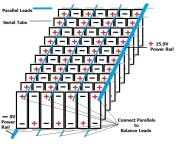tomjasz
1 GW
moved
Are all 18650 4.2?Allex said:18650 are actually 3.6V nominal. You always count the nominal value. 4.2V is at full charge.
tomjasz said:Are all 18650 4.2?Allex said:18650 are actually 3.6V nominal. You always count the nominal value. 4.2V is at full charge.
18650 Li-ion (LiCoO₂) are rated as either 3.6V or 3.7V, dependent on specific formulation.tomjasz said:Are all 18650 4.2?Allex said:18650 are actually 3.6V nominal. You always count the nominal value. 4.2V is at full charge.
4s2p 4 x 3.6V = 14.4Vtomjasz said:I've got some new salvaged 18650 batteries from laptop packs the read 3.7v, 24 of them, the packs say they were 14.4 volts but that doesn't add up. 8X3.7=29.6. Huh? Also I have 18 from a 3M projector that rated the battery pack at 10.85 or 11.1v. They read 3.6v. That math pans out. Please explain. 18650 batts that are 3.6v not 4.2? How do I utilize them? I was hoping for 7s for replacement in my little Schwann scooters for the 24v SLA. How do I charge them? Build them into a 7s6p and use a Tenergy 2a 25.9 smart charger? Can a balance charger be used? Wouldn't that be better since you seem to say these should be charged a lower input? Confused but having fun at collecting the goods. Soon to have a new salvage source that may be very prolific. So I need to figure this charging thing out. Is there a BMS out there that will work? Is there a balance charger that can be used as well?

You failed to eliminate the self discharging cell(s) before assembling pack. ? (don't believe dumun, self-discharging cells must be eliminated!!!)kje said:After balance charging and resting a few weeks my 3s50p batterypack is unbalanced without any discharging. My three banks are: 4.20V, 4.20V, 4.14V.
What should I do?
Add more cells to the weaker 4.14V bank?
tomjasz said:We found some solderless parts for building 18650 batts. There may be a new way. Sadly it came just as China goes on vacation.
